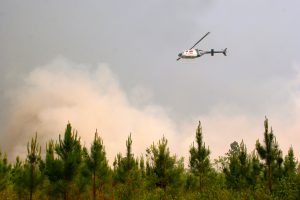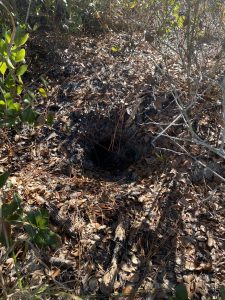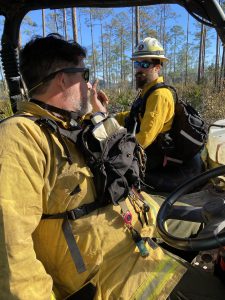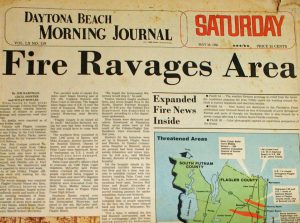WHAT IS A PRESCRIBED FIRE?
Prescribed fires, also known as prescribed burns, refer to the controlled application of fire by a team of fire experts under specified weather conditions to restore health to ecosystems that depend on fire. TL;DR: more prescribed fires mean fewer extreme wildfires.


WHY ARE PRESCRIBED FIRES IMPORTANT?

Forest ecosystems, like prairies, savanna, and chaparral, have evolved with fire serving an essential function for the health and wellness of its habitat. Over time, trees and other plant species become stressed due to overcrowding. Those that are outcompeted, for resources like sunlight and water, dry out and die off creating unburned fuels for future forest fires. Eventually, the conditions are just right for one or two small fires to grow into a massive wildfire. The longer it has been since the last fire, the greater the amount of unburned fuels and the greater the potential for a highly destructive wildfire that can consume large portions of the forest.
Fortunately, prescribed fires are one of the most versatile and cost-effective tools for effective land management.
Applying the right fire at the right time can:
- reduce the amount of hazardous fuels like dead trees and shrubs
- protect communities from extreme fires
- provide forage for game
- improve habitat for threatened and endangered species like the gopher tortoise
- promote the growth of grasses, shrubs, and other trees
WHO ACTUALLY EXECUTES A PRESCRIBED FIRE?

Fighting fires is a dangerous task, regardless of whether you’re fighting a prescribed fire or a wildfire. Firefighter and public safety is the first priority in every fire management activity. Prescribed burning requires a sophisticated team of trained fire experts to successfully execute each burn. The following is a list of the members you may find on a prescribed burn crew.
Prescribed Fire Manager – responsible for implementing and coordinating the prescribed fire activities.
Prescribed Fire Burn Boss – ensures all prescribed fire plan specifics are met before, during, and after a prescribed fire.
Firing Boss – leads ground and/or aerial ignition operations and coordinates with holding resources on fire incidents.
Firefighter Type 1 (Squad Boss) – leads a small group and is responsible for their safety on wildland and prescribed fire incidents.
Firefighter Type 2 (Crewmember) – serves on a crew performing fire suppression and fuels management duties.
Additional members can be assigned to a prescribed burn depending on overall objectives, topography, weather conditions, and other circumstances.
WHEN DO PRESCRIBED FIRES TAKE PLACE?
Prescribed burns can take place anytime throughout the year. Burns are conducted at different times depending on the overall goals of the burns. According to the Florida Fish and Wildlife Conservation Commission, burning during the spring and summer usually results in an increase in grasses and non-woody species, while burning during the fall and winter favors shrubby plants such as palmetto.
Here in the Southeast the season for burning typically takes place in the late winter and early spring. At this time of the year, weather conditions are generally more favorable and favorable. Prior to a burn, state forestry agencies work with county leaders (fire chiefs, emergency management personnel, county commissioners) to plan and implement community wildfire preparedness plans and programs to keep the public informed and safe. Safety is always the first priority in any fire management activity.
WHERE DO PRESCRIBED FIRES TAKE PLACE?
Many prescribed fires take place in what is known as the wildland-urban interface. The wildland urban interface is any area where homes and communities are built adjacent to wildland or agricultural vegetation. The wildland urban interface is the area that poses the greatest risk to public safety. According to the U.S. Fire Administration, Florida ranks 3rd in the nation for the greatest number of houses in the wildland urban interface.
Wildfires move quickly. They can surround people and their homes if firefighters are unable to get ahead of the fire to cut it off. Over the past 40 years, there have been nearly 100 significant wildfires (<10,000 acres burned) in Florida alone.
Flagler County experienced two significant wildfires, one in 1985 and another in the 1998. The Korona (1985) and Ware (1998) fires devastated homes in the town of Palm Coast. Although there were no deaths, these fires caused many injuries and reduced hundreds of homes to rubble.


During the Ware Fire of 1998, thousands of firefighters, from all over the United States, were brought in to try and contain the wildfire. It was the first and only time in Florida’s history, an entire county was evacuated due to wildfire activity.
 0
0
